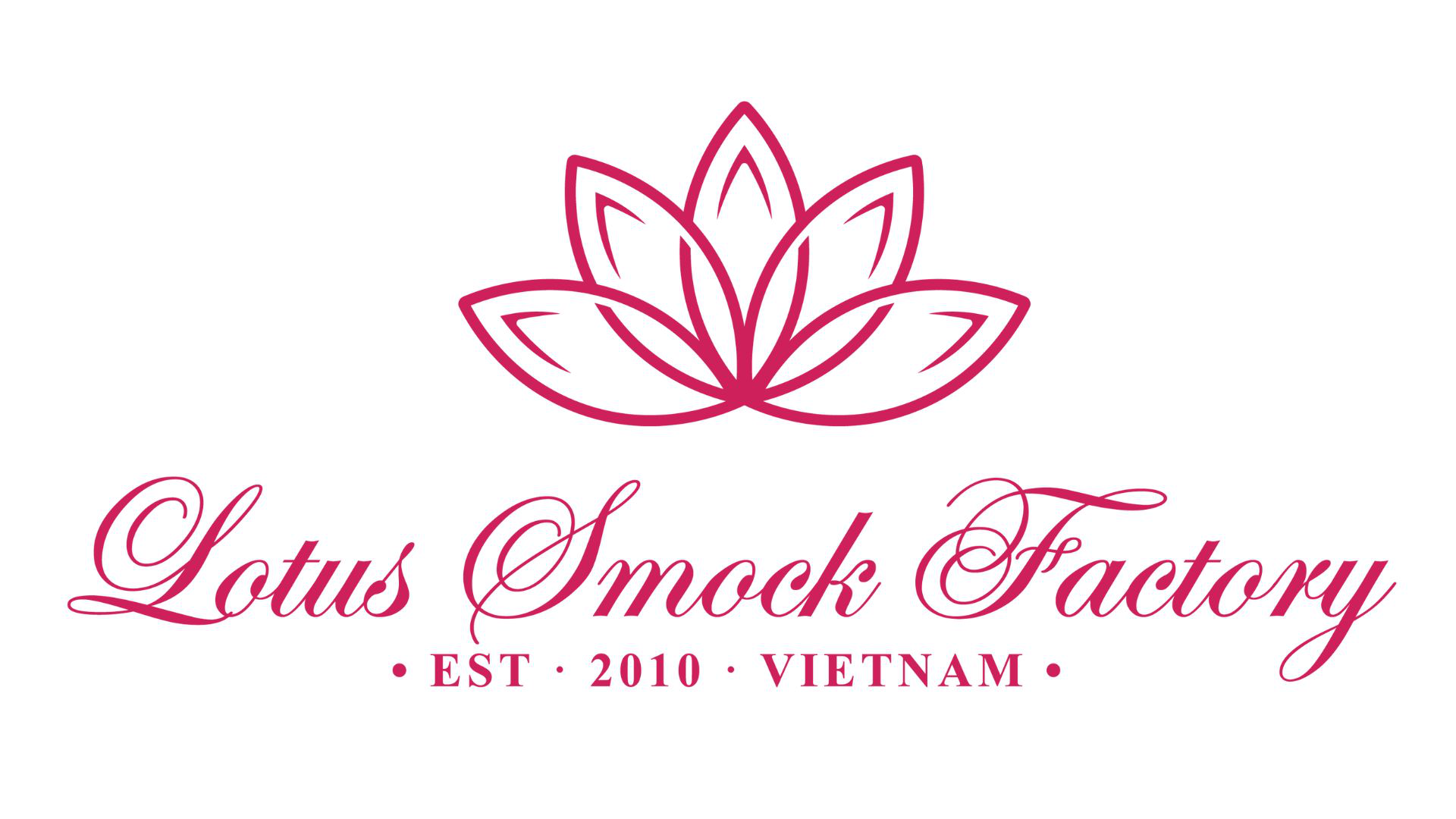How to Maximize Embroidery Business Profit Margin: A Complete Guide
The embroidery business profit margin shows how much money is left after covering costs such as machines, threads, and labor. Most embroidery shops earn between 20% and 60%, while some niche products like patches or baby clothes reach 65% or more. This margin makes embroidery one of the most profitable small business ideas when managed with the right pricing and production setup.
In this guide, you will learn how to calculate margins, see product examples, and apply strategies to grow your embroidery profits step by step.
1. What Is Profit Margin in an Embroidery Business?
The embroidery business profit margin shows how much money you keep after paying for all costs. It is the difference between what you charge customers and what you spend on machines, supplies, labor, and overhead.
There are two types of margins you need to know:
- Gross margin => Revenue minus direct costs (threads, stabilizers, blanks).
- Net margin => Revenue minus all costs, including rent, utilities, machine maintenance, and labor.
The formula is simple:
(Revenue – Costs) : Revenue × 100
Example:
- You sell a custom embroidered T-shirt for $25.
- Materials and direct costs are $8.
- Your gross margin is: ($25 – $8): $25 x 100 = 68%.
After you add overhead like labor and electricity, your net margin may be closer to 40–50%.
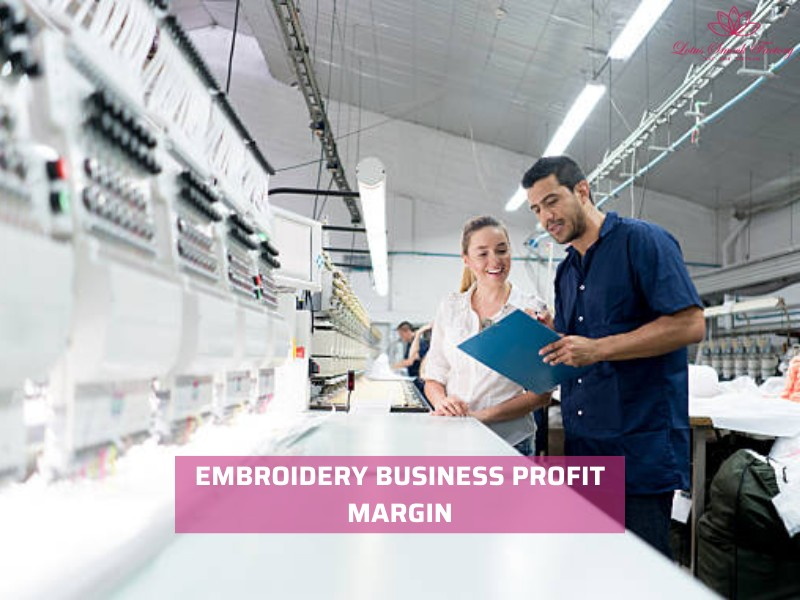
2. Average Embroidery Business Profit Margins in 2026
The average embroidery business profit margin in 2026 remains strong, with most reports showing between 20% and 60% depending on products and business setup. Some small shops focusing on niche products can even reach 65% margins.
Below is a list of high/low profit margin products and notes for embroidery shop owners.
High-margin products
- Patches and badges: Low material cost, high demand.
- Caps and hats: Popular with small businesses and events, often resold at 50%–60% margins.
- Monogramming services: Quick jobs with minimal thread use.
- Baby clothes and boutique outfits: Parents pay premium prices for custom and heirloom items.
Lower-margin products
- Bulk corporate uniforms: Often priced lower to win contracts. Margins may fall below 25% but bring steady volume.
Home-based embroidery vs commercial shops
- Home-based businesses keep overhead low, so margins can reach the upper range.
- Commercial shops with rent, staff, and utilities often work with slimmer margins but gain higher revenue through scale.
Whether you run embroidery from home or manage a shop, knowing which products deliver higher profit helps you plan smarter.
3. Key Factors Affecting Embroidery Business Profit Margin
Several factors directly shape the embroidery business’s profit margin. From machine choice to pricing, each decision impacts how much you keep from every order. Here are key factors:
3.1. Machine Investment and Maintenance
The machine is the backbone of your embroidery business.
- Startup costs vary => single-needle machines ($800–$1,500) vs multi-needle commercial machines ($7,000–$12,000).
- ROI timeline depends on order volume. A $5,000 machine can pay for itself in 6–12 months with steady sales.
- Breakdowns and repairs reduce margins. Regular servicing and proper use help avoid costly downtime.
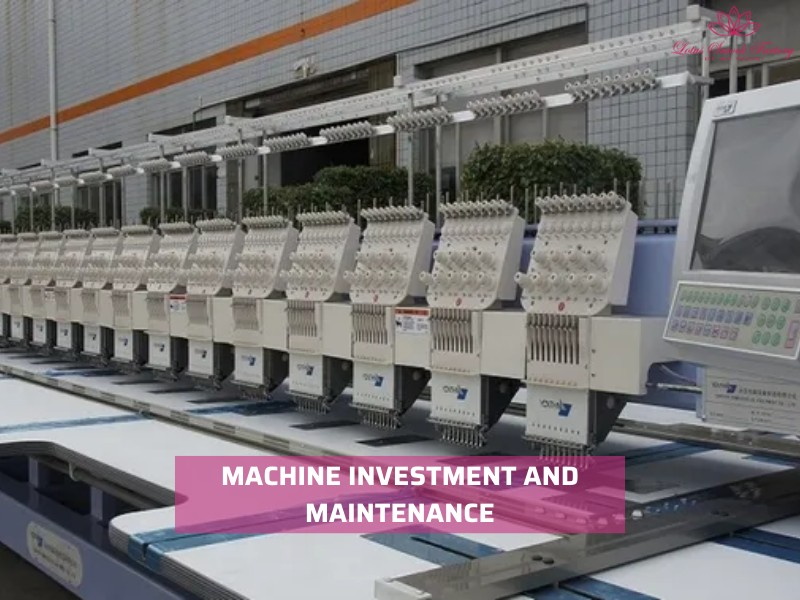
3.2. Material and Supply Costs
Materials are recurring expenses that quickly add up.
- Common supplies => threads, stabilizers, fabrics, and hoops.
- Wholesale buying lowers costs compared to retail purchases.
- Reducing waste, such as leftover thread or fabric scraps, helps protect margins.
3.3. Labor and Time Efficiency
Labor and speed affect how much you can produce each week.
- Output per hour varies => single-needle machines average 1–2 items, multi-needle can handle 5–10.
- In-house production keeps quality control but adds labor costs. Outsourcing saves time but reduces margins.
- Skill level and digitizing software efficiency make a big difference in turnaround speed.
3.4. Pricing Strategy and Market Position
How you set prices defines your final margin.
- Common models => per stitch, per design, or flat fee per item.
- Underpricing may bring orders but cuts margins below sustainability.
- Focusing on niche services (weddings, baby clothes, luxury gifts) often delivers higher margins than competing in general embroidery markets.
3.5. Example Embroidery Business Profit Calculation
- Selling price of custom embroidered cap: $20
- Material cost (cap + thread + stabilizer): $5
- Machine + labor cost allocation: $4
- Net profit: $11
- Profit margin = ($20 – $9) ÷ $20 × 100 = 55%
This example shows how a small embroidery order can bring high margins if costs are managed and pricing is set correctly.
4. Most Profitable Products for an Embroidery Business
The embroidery business profit margin varies by product type. Some items bring very high margins because of low material costs, while others rely on bulk orders to make a steady income. Below are the products that often give the best returns for small embroidery businesses.
- Custom Patches
High in demand for clubs, teams, and events. Material costs are very low, and margins often reach 60% or more. - Baby Clothes & Smocked Dresses
Parents are willing to pay premium prices for heirloom-quality items like Smocked children’s outfits/dresses. These products have a boutique appeal and can reach 55%–65% margins. - Corporate Uniforms
Bulk orders provide steady revenue but are usually priced lower per piece. Margins often stay around 20%–30%, but the volume makes up for it. - Caps and Hats
Popular for small businesses, events, and sports teams. They are easy to produce in batches and bring margins of 40%–55%. - Home Décor & Gifts
Items like pillows, towels, and napkins are often sold as custom gifts. These can achieve margins of 45%–60%, especially when marketed for weddings or holidays.
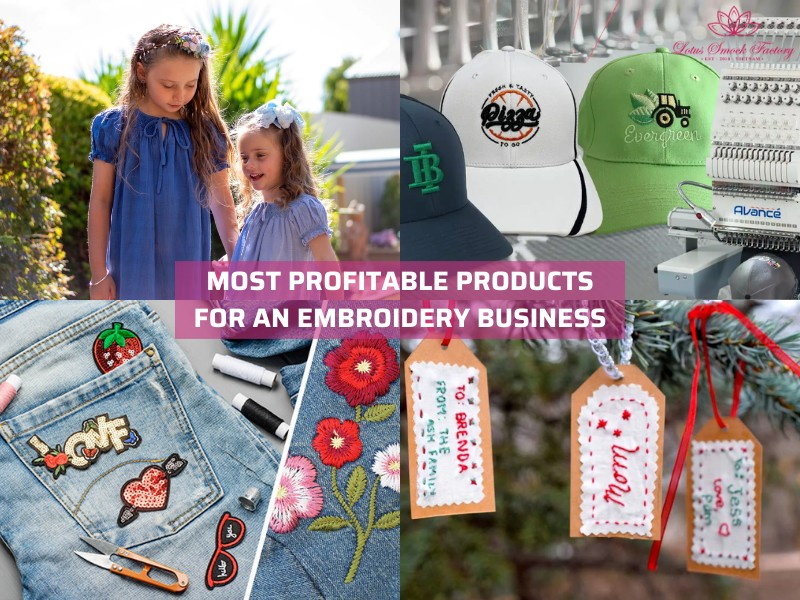
Profit Comparison Table
| Product Type | Avg Selling Price | Avg Cost | Profit Margin Range | Notes |
| Custom Patches | $5 – $10 | $1 – $3 | 50% – 65% | High demand, bulk orders easy to fill |
| Baby Clothes & Smocked Dresses | $40 – $80 | $15 – $30 | 55% – 65% | Boutique products, premium markup |
| Corporate Uniforms | $20 – $30 | $15 – $22 | 20% – 30% | Lower margin but steady volume |
| Caps and Hats | $15 – $25 | $7 – $12 | 40% – 55% | Popular for teams and events |
| Home Décor & Gifts | $25 – $50 | $10 – $20 | 45% – 60% | Strong in seasonal or wedding markets |
If you focus on high-margin products like patches, baby clothing, and gifts, your small embroidery businesses can achieve faster ROI while keeping production flexible.
5. Alternative to Maximize an Embroidery Profit Business – Partner with Lotus Smock
Running an embroidery business requires machines, training, and time. But not every boutique wants to deal with those challenges. A smarter option is to partner with Lotus Smock, a trusted smocked outfit supplier known for delivering handmade seasonal holiday dresses and embroidered children’s clothing. Instead of investing in equipment, boutiques can resell ready-to-wear smocked outfits with high resale margins.
5.1. What is a Lotus Smock?
Lotus Smock is a Vietnam-based smocked dress supplier for boutiques under TAQ Service Trading Development JSC. The brand focuses on creating handmade, heirloom-quality children’s clothing that combines traditional craftsmanship with modern boutique needs.
- Core Products: Smocked dresses, rompers, bishop dresses, seasonal holiday outfits (Christmas, Easter, Halloween, Valentine’s, and more).
- Target Market: Boutiques in the US, UK, and Australia, where demand for high-quality, embroidered children’s wear is strong.
- Craftsmanship: Each outfit is hand-smocked and hand-embroidered by skilled Vietnamese artisans. The difference between handmade and machine embroidery is visible in the detailing, giving the clothing higher value and appeal.
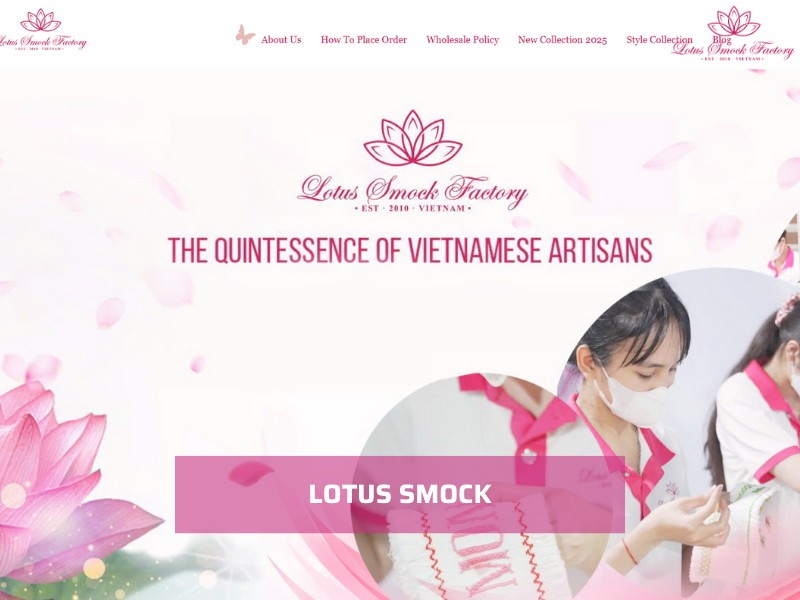
5.2. Good Profit Maximization Products from Lotus Smock
Lotus Smock offers a wide range of embroidered children’s clothing that helps boutiques maximize profits. These collections cover both evergreen styles and seasonal outfits, making it easier for shop owners to sell year-round.
| Style Collection | New Collection |
|
|
You can check the full list of good profit maximization products from Lotus Smock through “NEW COLLECTION PAGE” and “STYLE COLLECTION PAGE”.
5.3. Why Partner with Lotus Smock for Your Boutique?
When you partner with Lotus Smock, it means more than just sourcing children’s clothing. You will have a ready-to-sell profit model without the high costs of embroidery machines, supplies, or labor.
Here’s why boutiques worldwide choose Lotus Smock:
- Low Minimum Order Quantity (MOQ)
You don’t need to commit to large batches. Start with just 30 pieces per style, covering sizes from 3M to 6Y. This flexibility lets you test new designs without high risk.
- High Resale Margins
Handmade embroidery has strong customer appeal, especially for seasonal outfits like handmade Christmas dresses or Easter smocked clothing. Parents are willing to pay premium prices, so boutiques enjoy higher profit margins compared to mass-produced baby clothes.
- Customization Options
Boutiques can request monograms, adjust thread colors, or add holiday motifs such as reindeer, bunnies, or hearts. These personalization options make collections exclusive, boosting brand value.
- Fast Production and Shipping
Lotus Smock offers reliable timelines: 30–35 working days for production and 5–7 days of FedEx shipping. You can plan around seasonal peaks like Christmas or Easter with confidence.
- Heirloom Quality & Lower Return Rates
Each smocked dress is made by hand and hand-checked for stitching strength and colorfastness. Fabrics such as cotton voile and Swiss dot provide comfort and durability. Customers are more satisfied, which reduces returns and improves brand reputation.
Instead of investing thousands in embroidery machines and training, boutiques can sell ready-made smocked outfits from Lotus Smock with built-in profit margins and low upfront costs.
Note for New Store Owners
Before placing your first order, take time to analyze your target customers:
- Who are they? Young parents, gift buyers, boutique shoppers?
- What do they value? Seasonal exclusivity, handmade quality, or budget-friendly basics?
- Where do they shop? Online marketplaces, boutique stores, social media pre-orders?
- When do they buy most? Around holidays, back-to-school season, or christening events?
Understanding your customers’ interests, needs, and purchasing behavior helps you select the right mix of styles. For example, Christmas and Easter collections often sell out quickly, while classic white bishop dresses and rompers stay popular all year.
Contact Lotus Smock to Start Your Halloween Order:
- Facebook: facebook.com/lotussmockfactory
- WhatsApp: +84 83 333 3498
- Youtube: youtube.com/@LotusSmockFactory
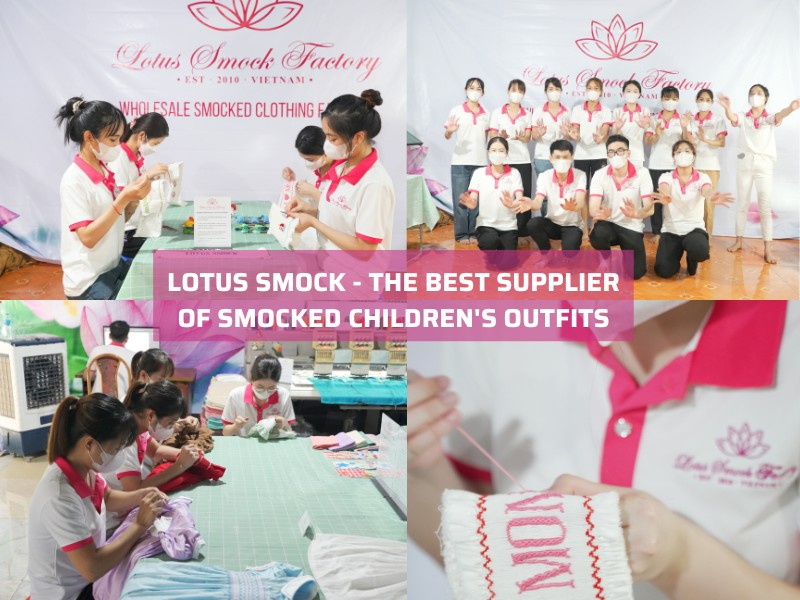
6. FAQs
6.1. Q1: What is the average embroidery business profit margin?
Most embroidery businesses report margins between 20% and 60% depending on the product and pricing model. Higher-end items like boutique baby clothes or personalized gifts can reach 50%–65%, while bulk uniform orders usually sit at the lower end.
6.2. Q2: How much can a home-based embroidery business earn per month?
A home-based embroidery business can earn anywhere from USD 500 to USD 5,000+ per month. Earnings depend on machine capacity, hours worked, and whether you target small retail orders, custom gifts, or bulk clients.
6.3. Q3: What embroidery products give the highest margins?
Products with the best margins include:
- Custom patches: low material cost, high demand.
- Baby clothes and smocked dresses: boutique appeal, strong markup.
- Caps and hats: fast production, good resale value.
6.4. Q4: How do embroidery shops compete with mass imports?
Shops compete by offering:
- Personalisation (names, monograms, logos).
- Faster turnaround for local clients.
- Higher quality control than imported, mass-produced goods.
- Niche focus, such as weddings, baby boutiques, or corporate gifts.
6.5. Q5: How long does it take to break even on an embroidery machine?
On average, small businesses recover their investment in 12–24 months. A basic single-needle machine costs around USD 800–1,500, while a commercial multi-needle machine can cost USD 8,000–12,000. The exact payback period depends on your order volume and profit margins.
7. Final Words
The embroidery business profit margin depends on smart cost control, efficient machines, and the right pricing model. While most businesses work within the 20%–60% range, you can push higher by focusing on high-value products and wholesale supplies. If you want the rewards of embroidery without handling machines, supplies, and training, you can also partner with suppliers like Lotus Smock for ready-made embroidered clothing with built-in profit potential.
Start reviewing your costs and products today so you can set prices that grow your embroidery profits with confidence.
